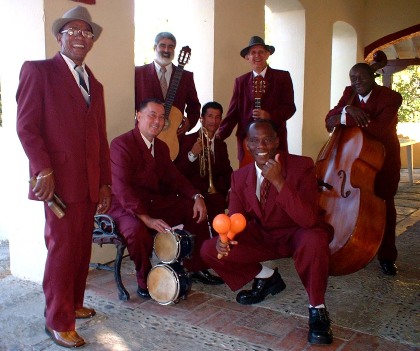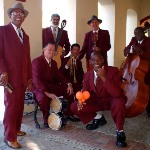- country:Cuba
- style(s):Son
- artist posted by:Concerts.pl
Links
Cuban son legend
80 years history (1927 – 2007)
The history of the Septeto Nacional is closely associated with one musician, who, were there a Pope for Cuban son, would long since have been canonised - Ignacio Piñeiro, an excellent sonero, singer and composer Piñeiro lived in Pueblo Nuevo, the black quarter of the city.
Even as a child, Ignacio Piñeiro sang in choirs and played drums with the Afro-Cuban cabildos Then he formed his own first line-up, Los Roncos, the Hoarse Ones, for which he composed choir music.
In 1926 he played bass with the Sexteto Occidente, whose leader was Maria Teresa Vera.
Piñeiro travelled to New York with this sextet and on his return to Havana he immediately set about making history with son: in 1927, together with the troubadours Juan Ignacio de la Cruz Hermida, Bienvenido León Chacón and Alberto Villalon, who until then had performed as a trio,
plus the tres player Francisco González and José Manuel Incharta on bongos, he founded the Sexteto Nacional - under contract to Colombia Records in Havana, who had been eagerly searching for a band capable of competing with the Sexteto Habanero, who were under
contact to RCA Victor.
Not only did Piñeiro write countless sones for his sextet, which became a septet only a few months later with the cornet player Lázaro Herrera, he also played bass in the new line-up.
The Septeto National played around the dock on all Havana`s radio stations and gave concerts on public squares and in theatres; the capital city was raving about the new sound - a son cubano, certainly, but not the simple form brought from Santiago to Havana by the troubadours, but more refined, with a cornet and artistically arranged harmonious parts, strongly syncopated and eminently danceable, like Piñeiro`s greatest hit "Échale salsita" - this son is regarded as the original form
of salsa.
In 1932 George Gershwin travelled to Cuba and happened to turn on the CMCJ radio station when the Septeto Nacional were playing Piñeiro`s sones.
Gershwin visited Piñeiro and the two men became friends. Gershwin studied Piñeiro’s sones and even cited "Échale salsita" in his own "Cuban Overture" But other Septeto Nacional hits had also become part of the classic repertoire of nostalgic son line-ups and modern salsa bands: for example "No jueges con los Santos", "There`s no playing with the Gods", a half-joking, half-earnest warning about respecting the Afro-Cuban gods, an early musical demonstration of black consciousness.
In the late 1920s, Havana`s dance enthusiasts witnessed a musical sparring match for which there is no comparison in the history of Cuban music.
For two whole years, the Sexteto Habanero and Piñeiro`s Sexteto Nacional (when Piñeiro enlarged his sextet into a septet, the Sexteto Habanero did likewise) confronted one another in the form of three simultaneous recording sessions - a master performance in terms of strategy and psycho-terrorism, especially as the two sextets, or septets, worked with one and the same lead singer: Abelardo Barroso, also called "the great Caruso". Even their repertoires were identical in parts.
The mulatto Abelardo Barroso had been singing with the Sexteto Habanero since 1925, that is to say, with Ignacio Piñeiro`s competitors. For Barroso, this had been his fourth attempt to make something of his life; he had tried his hand as a chauffeur, a boxer and a pelota player, and had failed each time. But there was still music, and it was as a singer that Abelardo Barroso finally got lucky. In the end, Barroso became an idol as the acclaimed lead singer in the two most renowned son line-ups.
In spring 1929, the Septeto Nacional had a brief moment of victory over their competitors, when they were selected to travel to the Ibero-American Fair in Seville and perform son at the Cuban pavilion. In 1933, the Septeto Nacional was invited to the "Century of Progress" World Exposition in Chicago, where they not only gave concerts but also made records and were awarded a gold medal.
The Septeto Nacional`s turn-over in musicians was so fast that one scarcely knew who to expect on stage when the Septeto Nacional was finally announced.
That same year Ignacio Piñeiro left his septet, who had to assert themselves against the competition of innumerable son formations. Despite all the concerts and radio broadcasts, the musicians earned very little, and Piñeiro gave up for financial reasons.
Lázaro Herrera took his place, but the Septeto Nacional could only keep its head above water for another two years; the famous septet was disbanded in 1937." In 1940, the singer and sonero Miguelito Valdés brought the septet together once again for a recording session.
The musicologist Odilo Urfé succeeded in doing the same thing again for a television appearance in 1954. At that time, the cha-cha-cha held sway over the dance halls, and the existing son orchestras had long since expanded into conjuntos, with a strong wind section; the "home-made" sound of the old son septets, with only one cornet, sounded outmoded, passé.
It was some years before audiences rediscovered the nostalgic sound of the 1920s.
After the Revolution of 1959, the Septeto Nacional was upgraded and the musicians from the original line-up (Lázaro Herrera and Bienvenido León) invited for interviews. The Septeto was able to record several LPs and performed, above all, in the traditional "Casas dla la Trova". In the course of time, the Septeto Nacional line-up became younger; a logical step. The new musicians, however, had no difficulty whatsoever in imbuing the unbeatable charm of the old sones with new spirit.
The third generation of the Septeto National can certainly stand up to comparison with the legendary band`s original line-up.
All the musicians are excellent instrumentalists and inspired soneros, who play the fresh-sounding arrangements, as if a time machine had catapulted the original Septeto from the beginning to the end of the twentieth century. It is always a risk to do new recordings of seventy-year-old classics, which even the children in Cuba know, true to the original and yet filtered through time.
When such an enterprise succeeds, one can only speak of a rare and almost philosophical stroke of luck. And here we have that stroke of luck (thanks be to the orishas!).
There is nothing at all outmoded about sones like "No juegues con los Santos" or Piñeiro`s hypnotic "Coco mai mai", which have been kept close to the original One could almost swear that were the original Septeto Nacional founded not in 1927 but in 1995, that is to say, after mambo, cha-cha-cha, descargas, salsa and latin-jazz, they would sound just like this.
And this is due, apart from the clever arrangements and the top-notch musicians, above all to the smoky voice of the lead singer, Raspa.
Selected discography from last period:
CD “El Sabor de la Tradicion” (Ferment, 2005)
CD “Poetas Del Son” (Le Chant Du Monde 2003) – Grammy nomination 2004 !!!
CD “De Cuba Son Matamoros” (Bis Music, 2000)
CD “Mas Cuba Libres“ (Network, 1999)
CD “Son Soneando” (CI, 1999)
CD “Putumayo presents Cuba” (Putumayo, 1999)
CD “Havana Mood” (A.P.C., 1999) – produced by Bill Laswell !
CD “Soneros De Cuba” (RealRhythm, 1998)
CD “Pineiro Se Baila Con Son” (Sonpat, 1997)
CD “Tradicion” (Corazon, 1997)
CD “El Son De Cuba” (Egrem, 1996)
CD “Cuba: El Camino De La Salsa” (Network, 1995)



